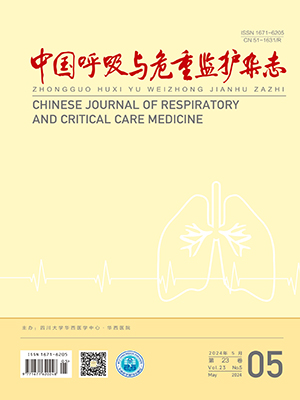| 1. |
Kress JP. Sedation and mobility: changing the paradigm. Crit Care Clin, 2013, 29(1): 67-75.
|
| 2. |
岳锦熙, 黄青青, 苏美仙, 等. 舒芬太尼对机械通气重症患者的镇痛镇静作用. 中华危重病急救医学, 2016, 28(6): 563-566.
|
| 3. |
刘京涛, 杨毅, 安友仲, 等. ICU 患者镇静深度的思辨: 是否应当浅镇静. 中国急救医学, 2017, 37(2): 97-101.
|
| 4. |
杨杰, 康焰. 镇静对机械通气患者呼吸功能的影响. 中华危重病急救医学, 2017, 29(9): 857-860.
|
| 5. |
Barr J, Fraser GL, Puntillo K, et al. Clinical practice guidelines for the management of pain, agitation, and delirium in adult patients in the intensive care unit. Crit Care Med, 2013, 41(1): 263-306.
|
| 6. |
Shehabi Y, Bellomo R, Reade MC, et al. Early goal-directed sedation versus standard sedation in mechanically ventilated critically ill patients: a pilot study. Crit Care Med, 2013, 41(8): 1984-1990.
|
| 7. |
郑毅隽, 宣丽真, 诸杜明. 早期目标导向镇静: 体现精准医疗. 中华重症医学电子杂志, 2016, 2(2): 102-105.
|
| 8. |
Sessler CN, Gosnell MS, Grap MJ, et al. The Richmond Agitation-Sedation Scale: validity and reliability in adult intensive care unit patients. Crit Care Med, 2002, 166(10): 1338-1344.
|
| 9. |
Mehta S, Burry L, Fischer S, et al. Canadian survey of the use of sedatives. analgesics, and neuromuscular blocking agents in critically ill patients. Crit Care Med, 2006, 34(2): 374-380.
|
| 10. |
蔡柏蔷. 机械通气时镇静剂、镇痛剂和肌松剂的临床应用. 中国呼吸与危重监护杂志, 2004, 3(3): 142-144.
|
| 11. |
周卫萍, 王竹敏. ICU 机械通气患者镇痛镇静护理的研究进展. 中国中西医结合急救杂志, 2017, 24(5): 556-560.
|
| 12. |
翁云龙. 机械通气患者过度镇静与临床预后关系的回顾性队列研究. 中国中西医结合急救杂志, 2015, 22(5): 508-512.
|
| 13. |
阳书坤, 谢江霞, 霍开秀, 等. 右美托咪啶与咪达唑仑对慢性阻塞性肺疾病急性加重期机械通气患者镇静的比较研究. 中国呼吸与危重监护杂志, 2013, 12(5): 481-484.
|
| 14. |
吴永红, 贡浩凌, 高燕, 等. 持续浅镇静目标导向调控方案在机械通气患者中的应用研究. 中华护理杂志, 2017, 52(4): 400-404.
|
| 15. |
Guillermo B, Eduardo T, Auirre M. The implementation of an analgesia-based sedation protocol reduced deep sedation and proved to be safe and feasible in patients on mechanical ventilation. Rev Bras Ter Intensiva, 2013, 25(3): 188-196.
|
| 16. |
李双玲, 王东信, 杨拔贤. 重症加强治疗病房成人患者浅镇静治疗进展. 中华危重病急救医学, 2016, 28(1): 89-93.
|
| 17. |
黄洁, 肖倩, 吴瑛, 等. ICU 谵妄危险因素的 Meta 分析. 中华护理杂志, 2010, 45(1): 6-9.
|
| 18. |
平丽, 邵亚娣, 俞丽丽, 等. 以浅镇静为目标导向性程序化镇静镇痛方案在机械通气重症患者中的应用效果. 中华现代护理杂志, 2016, 22(26): 3793-3795.
|
| 19. |
徐建宁, 汪国建, 冯洁惠. 早期目标导向型镇静用于 ICU 机械通气患者的效果评价. 护理学杂志, 2016, 31(10): 25-28.
|




